by Paula Schlueter Ross and James Heine
Katrina Revisited: God Sent Angels
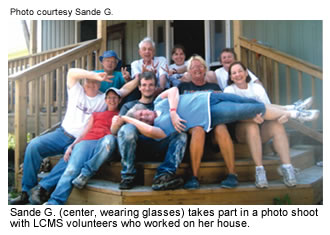
Three years after back-to-back Hurricanes Katrina and Rita destroyed hundreds of thousands of homes and changed forever the lives of a million Gulf Coast families, Lutheran volunteers are making a difference, rebuilding one house—and life—at a time. But there’s still lots more to do and workers are still needed to lend a hand.
Sande G., a 50-something homeowner in East New Orleans, says the mold in her twice-flooded living room was so extensive, “if it was a science project, we would’ve gotten an A-plus.”
The water climbed to 8 feet, 9 inches outside—and 27 inches inside—Sande’s elevated house as a result of citywide flooding from Hurricanes Katrina and Rita in late-August and mid-September 2005.
She and her husband, Don, who had evacuated days before Katrina made landfall, couldn’t get past National Guardsmen to return to their home for a month afterward. And local red tape prevented them from getting a building permit for a full year.
But now, three years after the storms, those once-moldy walls have been replaced and painted a striking blue-gray. The floors gleam with “Monterey maple” hardwood. There are rebuilt front and back porches. New doors and windows.
It’s not finished, but it’s getting there, Sande says, thanks to Lutherans and others across the country who have sacrificed their own time and money to travel to New Orleans to help people they’ve never met.
“I’ve been totally elated by total strangers,” says Sande, who’s received about 100 notes, cards, and e-mails from dozens of Lutherans who’ve helped rehab her house.
She’s been through a lot: the loss of her home of 20 years; a robbery at gun-point in the on-site trailer where she now lives; the untimely death of her hus-band, Don, of a heart attack just last fall.
“We had pretty much lost hope,” she says of the months following what she calls “the storm.” (She still can’t bear to say the word Katrina.)
And then, the Christians came: to pray with her and help her rebuild—her house and her life.
“All of a sudden, we were praying again,” said Sande, a Presbyterian who had drifted away from the church. “It was like we had our faith back. It was like, we didn’t feel God’s presence, and then—because of the people we met—we knew He’d been here all along.”
A District Responds
Sande’s words don’t surprise Rev. Kurtis Schultz, president of the Synod’s Southern District, whose own home in Slidell, La., was flooded and who for five months was displaced from the New Orleans-based district office by the storms’ one-two punch.
Even though Schultz is back in his refurbished house, he still finds it “difficult to breathe” when he sees photos of the Gulf Coast devastation. He knows that those who’ve had their lives turned upside-down, like him, are “very, very receptive” to the prayers and care of Christians.
Talk to the people in the streets, talk to local government officials, Schultz says, and “they’ll tell you: If it was not for the church, there would be no recovery.”
But, he’s quick to add, that recovery is “continuing” and is far from over.
After three years, the two hospitals in the city’s east side still haven’t reopened. Take a drive through the neighborhood and you can still make out fading floodwater lines six feet high on walls and windows. Rehabbed buildings in various stagesof repair sit alongside those with the spray-painted red X’s of disaster inspectors. There are still lots of “For Sale” signs, boarded-up windows, and piles of debris at the curb.
Residents who fled are starting to move back, but, in some hard-hit areas, fewer than half have done so.
“We know the work could continue for another seven years,” Schultz says.
With its offices now relocated in Mandeville, La., the Southern District has built an extensive disaster-response network called Recovery Assistance Inc., or RAI, that works to provide hope to hurting people under the motto “Restoring Faith, Home, and Community.”
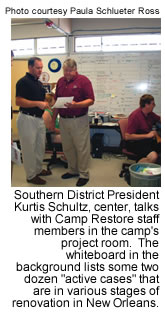 RAI manages two properties that house out-of-town volunteers—Camp Restore in New Orleans, and Camp Biloxi in Biloxi, Miss.—and includes LINC New Orleans, which works with local leaders to strengthen communities; Restoration Education and Evangelism (Re)Institute, which offers regional training to help Christians reach out with their faith during disasters; and a ministry-restoration arm that supports church workers, congregations, and schools.
RAI manages two properties that house out-of-town volunteers—Camp Restore in New Orleans, and Camp Biloxi in Biloxi, Miss.—and includes LINC New Orleans, which works with local leaders to strengthen communities; Restoration Education and Evangelism (Re)Institute, which offers regional training to help Christians reach out with their faith during disasters; and a ministry-restoration arm that supports church workers, congregations, and schools.
Since the storms, the district has received more than $7 million from individuals and groups—including LCMS World Relief and Human Care, Orphan Grain Train, and Thrivent Financial for Lutherans—and has spent about $5 million to date, mostly to operate the two camps, which have fed, housed, and trained 22,000-plus clean-up volunteers from all 50 states and 30 foreign countries. Many have served more than once, and some have returned up to 10 times to help out.
“The servant heart of the Synod is beating strong in this place,” Schultz said recently at Camp Restore, where more than 100 mostly teenage volunteers sat at long tables in the Prince of Peace Lutheran Church gym—now the camp’s cafeteria—soberly watching an orientation slideshow about the disaster before they began their first day of work.
Needs Are ‘Numerous’
Even after three years, the needs of Katrina victims “are demanding and numerous,” according to Pam Hunter, RAI’s resource manager, who takes phone calls all day long—and sometimes after she’s left the office, on her cell—from people who need help.
Hunter estimates that up to 70 percent of those with damages are still replacing lost items, such as washers, dryers, refrigerators, furniture—even mattresses. She has 200 names on her “to help” list, she says, and as a Katrina survivor who was rescued from her roof and lost everything, she knows how helpless they feel. She still has “ups and downs” and suspects she has post-traumatic stress, because “I’m reliving [the disaster] all the time” at work, and, because of the never-ending needs, “I don’t have time to unwind.”
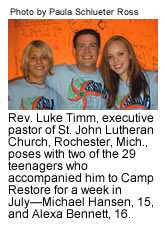 Her own house was rehabbed by volunteers—”God sent angels,” she says—and if it weren’t for them, she figures, “a good 95 percent of the work that’s been done would not have been done.” Even when government aid was lagging and nonexistent, the volunteers, she says, “were here from the beginning.”
Her own house was rehabbed by volunteers—”God sent angels,” she says—and if it weren’t for them, she figures, “a good 95 percent of the work that’s been done would not have been done.” Even when government aid was lagging and nonexistent, the volunteers, she says, “were here from the beginning.”
That sentiment is echoed by Corinna Hollar, communications manager at Camp Biloxi, who says out-of-town Lutherans started showing up to help within days of Hurricane Katrina, sleeping in the pews of Good Shepherd Lutheran Church, Biloxi, where the camp is now located.
In those early days, she said, the volunteers would accompany her husband, Good Shepherd Pastor Eric Hollar, in walks around the hard-hit community, asking residents how they could help.
Even today, with both camps stocked with every tool necessary to build a house, as well as dormitories, dining halls, and mobile kitchens, volunteers housed there still go on “prayer walks” through local neighborhoods, asking residents if they have prayer—or other—needs. Almost all of them do.
Says Rev. Ed Brashier, chaplain and director of Camp Restore: “Even though things look better than they did two or three years ago, the desolation of mind and spirit remains.”
Sharing faith is the most important aspect of the recovery work, according to Schultz, who says “the total heart of what we do . . . is turning critical incidents into ‘critical events’”—those one-on-one Gospel-sharing experiences that make up the Synod’s worldwide Ablaze! initiative.
Simply put, it’s one person sharing his or her Christian faith—and hope—with another.
Even a garage sale hosted at Camp Restore had a Lutheran message. As local residents chose tagged items and brought them to the checkout to pay, “We totaled the amount up and said, ‘It’s free. Because that’s what grace is about—it’s free,’” Schultz recalled. “They were very moved.”
“We’re rebuilding houses,” explains Rev. Dave Buss, executive director of RAI, “but our focus is on sharing the hope of Christ.”
Making a Difference
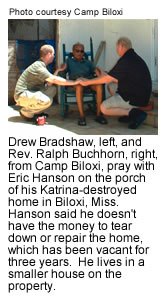 Judging from New Orleans’ bustling French Quarter, eight miles from Camp Restore, and Biloxi’s busy casinos, a couple of miles from Camp Biloxi, one might think every-thing’s back to normal on the once-devastated Gulf Coast.
Judging from New Orleans’ bustling French Quarter, eight miles from Camp Restore, and Biloxi’s busy casinos, a couple of miles from Camp Biloxi, one might think every-thing’s back to normal on the once-devastated Gulf Coast.
But Lutheran relief workers know better.
“We were one of the first faith-based groups working here, and [we] continue to be here long after many others have left the area or closed,” says John Coyle, director of Camp Biloxi.
But, he adds, “we have many more houses to finish than we have completed. I think we will be at this for many more years.”
Volunteers at both Southern District work camps have helped almost 2,000 families get back into their homes to date, with 3,000 more currently on waiting lists.
Schultz says “everybody knows who we are and what we do, and that’s a good and vital witness.”
The Southern District, he adds, will continue its ministry to help the Gulf Coast rebound “as long as there are dollars— and volunteers.”
Christie Kieschnick of RAI’s LINC New Orleans says local Christian churches have turned the disaster “into this incredible evangelical movement.” People are responding to the church unlike ever before, Kieschnick says, because “they’re seeing [Christians] actually be Jesus in the streets” instead of simply worshiping behind closed doors on Sunday mornings.
It’s also brought church and community leaders together to discuss problems and find solutions—an invaluable resource that she prays can be replicated elsewhere, whether or not there’s a disaster.
“I think God has given us a gift here,” she said of the post-Katrina partnerships.
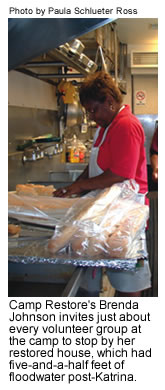 Those connections make sense to Sande G., who, in spite of her storm-related troubles, treasures her newfound Lutheran friends in Florida, Illinois, Indiana, Michigan, Minnesota, Missouri, New York, Pennsylvania, and Texas—the former strangers who “came down here, wallowing in the mire when they didn’t have to, to sweat with us.”
Those connections make sense to Sande G., who, in spite of her storm-related troubles, treasures her newfound Lutheran friends in Florida, Illinois, Indiana, Michigan, Minnesota, Missouri, New York, Pennsylvania, and Texas—the former strangers who “came down here, wallowing in the mire when they didn’t have to, to sweat with us.”
She laughs when she recalls the teens who came up with a song, “Sandin’ at Sande’s,” and another high-spirited youth group who left silhouettes of themselves on her bathroom wall (which she loves).
“Can you imagine what that house is going to be like to live in, with all the good Christian hearts [built into it]?” she asks.
According to Sande, “God’s love is evident in the people, not the things.
“I’ve been so blessed,” she says, “and the work that’s been done on my house is the least of my blessings.”
Extending a Helping Hand
By now, we are all familiar with the dramatic pictures from this year’s early-summer flooding in the Midwest. Experts estimate that property, personal, agricultural, and business losses may run into the billions.
In July, Rev. Dave Buss, executive director of the Southern District’s Recovery Assistance Inc. (RAI) Ministries, sent an e-mail to some 20,000 RAI donors and volunteers, asking them to “help us help the folks affected in the Midwest!”
The flooded states—Wisconsin, Minnesota, Indiana, Illinois, Missouri, and Iowa—“are dear to us,” Buss said, because of the thousands of volunteers they have provided to the Gulf Coast since Hurricanes katrina and Rita in 2005.
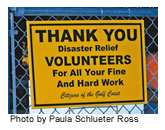 Equipment used to clean homes in Louisiana and Mississippi already has been sent to Midwestern sites, and Buss and other RAI and Southern District staff have connected with their counterparts in the affected districts “to offer our support and expertise, and to walk with them through their time of response,” according to Southern District President kurtis Schultz. —P.S.R.
Equipment used to clean homes in Louisiana and Mississippi already has been sent to Midwestern sites, and Buss and other RAI and Southern District staff have connected with their counterparts in the affected districts “to offer our support and expertise, and to walk with them through their time of response,” according to Southern District President kurtis Schultz. —P.S.R.
If you’d like to help Gulf Coast or Midwest families who still have needs, here are some ideas from Lutheran relief workers on what you can do:
- Pray—for those who are still hurting, and for Lutheran workers there.
- Volunteer—a week or more to help out.
- Give—a cash or in-kind donation. RAI accepts all kinds of local donations for Gulf Coast families, from bed linens and towels to refrigerators and washing machines. For out-of-state donors, checks are the best option, as they can be used for a wide range of needs. And, on-site purchases help the local economy. To give a tax-deductible donation, make checks payable to “Recovery Assistance Inc.” and mail to the RAI office at 9301 Chef Menteur Highway, New Orleans, LA 70127.
To help families affected by this year’s Midwestern floods, send donations designated “Flood Relief 2008” to LCMS World Relief and Human Care, P.O. Box 68661, St. Louis, MO 63166-6861. Or call the credit-card gift line at (888) 930-4438. Online gifts also may be made at http://givenowlcms.org.
For more information:
- RAI: visit its Web site at www.raiministries.org.
- Camp Restore: (888) 248-2636 or visit www.camprestore.org.
- Camp Biloxi: (228) 594-0008 or visit www.campbiloxi.org.
By Paula Schlueter Ross
In Cedar Rapids: Faith and Christian Love Sustain Lutheran Families
On any given Sunday, too much kibitzing before the service is apt to dismay Rev. Jerry Doellinger. He knows some members assembled at Concordia Lutheran Church in Cedar Rapids, Iowa, use the time to meditate, and sometimes the socializing proves distracting to those who wish to spend the time in prayer.
On June 15, the nave of Concordia was abuzz with conversation—literally—but Doellinger was not in the least dismayed. Two days earlier, on Friday, June 13, the placid Cedar River had crested at 31.12 feet, nearly 20 feet above its normal flood stage and more than 11 feet above the previous record set in 1929. The June 9–21 Cedar River flood inundated much of the central portion of the community.
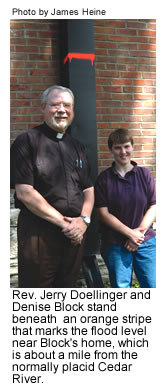 “This was a visiting of Christian love and outpouring,” Doellinger says about the pre-service socializing June 15. “Everyone was talking and hugging and visiting, trying to touch base with one another. We had 10 families who were displaced by the flood, and another family lost its business. I didn’t know if I was going to get the service started or not.”
“This was a visiting of Christian love and outpouring,” Doellinger says about the pre-service socializing June 15. “Everyone was talking and hugging and visiting, trying to touch base with one another. We had 10 families who were displaced by the flood, and another family lost its business. I didn’t know if I was going to get the service started or not.”
The service finally began with a cathartic hymn-sing that allowed a lot of pent-up feelings to be released, Doellinger recalls. “There was a very special spirit here,” he says. That spirit, anchored in faith, seems typical of other congregations in Cedar Rapids, Doellinger adds. “In visiting with other pastors who had losses—they’re recounting the same kinds of stories.”
Among the congregations in his circuit—Doellinger is counselor for the Iowa District East’s Cedar Rapids North Circuit—Concordia, along with Bethany and Trinity, were probably hit the hardest, Doellinger says. “Trinity had 40 members who were affected. Bethany had eight or nine. Families at St. Paul, Marion; King of Kings, Cedar Rapids; and Zion, Hiawatha, were also affected.”
While significant for the affected congregations, the LCMS numbers reflect just a small portion of the community crippled by the flooding, Doellinger notes. According to Corridor Recovery, an Iowa Web site that serves as a clearinghouse for the metropolitan region that extends along the river, the flood damaged more than 5,000 Cedar Rapids residential parcels and 1,000 commercial parcels.
Prayers, Tears, and Help
As in New Orleans and along the Gulf Coast, the road to recovery in Cedar Rapids may be long. Driving down Ninth Street and walking into what remains of Tim and Denise Block’s Cedar Rapids kitchen brings home the magnitude of the job ahead. Predictably, three weeks after the crest, the empty kitchen walls are covered with spots of mold, and what remains of the cabinets is covered in dark grime. Actually, much of the kitchen, as well as the rest of the main floor and basement, of the once-tidy yellow frame house is piled outside, alongside the curb. (One of the first sights that greets a summer visitor to Cedar Rapids is block after block of refuse piled high along the curbs.)
“We had six feet of water on our first floor,” says Denise Block, who teaches seventh and eighth grade at Central Lutheran School in nearby Newhall, Iowa, and along with her family, is a member of St. Stephen Lutheran Church in Atkins. “When we evacuated, we thought we might have six inches on the first floor, because of the projected crest. Instead, we got six feet.”
As bad as the first floor appears, the basement is worse, Block adds. She even has questions about the structural integrity of the concrete-block foundation. “At this point, we don’t think the house is reparable.”
Across the street, Concordia members Ron and Heidi McKay face a similar situation. Much of the interior of their home is already bare except for the stud and bearing walls. “We’re probably looking at an 80- to 90-percent loss,” Ron McKay says, and we’ve also just learned that both of our jobs may be in jeopardy.”
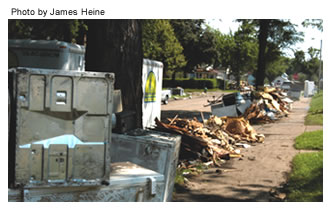
Like many of their Ninth Street neighbors, neither the Blocks nor the McKays have flood insurance. Much of the street is a mile or more from the Cedar River and outside the river’s official 100-year flood plain, Block explains.
“We were designated as living in the 500-year flood plain, so flood insurance was not mandatory,” she says. “No one thought we would need it.”
Her consolation, Block adds, has been her faith—and the prayers and generous support “of lots of people.”
There have been tears, too, she says, not only because of grief, but also because of the great kindness of people.
“I’ve been thinking, ‘What will I talk about with my students this year? What is my message going to be?’ It’s the Christian love that we have and how God unfolds things for you that you wouldn’t expect. Help comes from places and from people you don’t know. All of our needs, so far, have been taken care of from the first day of the flood.”
There are also the “little things” that you become aware of, Block adds, things that you may not think much about in everyday life. “God put us here with good friends and good co-workers and a good community of churches. It’s just been unbelievable, in that way, just as unbelievable as the flood has been.”
Doellinger agrees: “I get a little emotional yet, but the way the congregation has come together is just amazing. People that you’d never expect are opening their hearts, their wallets, their doors. They’re taking time off work to help people clean up. They’re willing to do whatever they can, in so many ways. Yes, the waters may rage, but we lift our eyes past the momentary disaster and we look to the Lord.”
Editor’s note: In a follow-up conversation shortly before we sent the September Lutheran Witness to the printer, Rev. Doellinger reported that the Blocks have opted to purchase another home while the McKays have begun rehabbing their Ninth Street residence. The McKays have also found more secure jobs, he said.
‘With the Cross of Jesus’
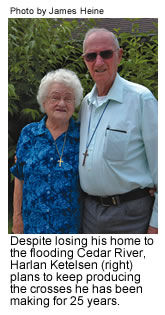 Despite losing his home to the flooding Cedar River, Harlan Ketelsen (right) plans to keep producing the crosses he has been making for 25 years. Click here to read more about Ketelsen and his wife, Marge.
Despite losing his home to the flooding Cedar River, Harlan Ketelsen (right) plans to keep producing the crosses he has been making for 25 years. Click here to read more about Ketelsen and his wife, Marge.
By James H. Heine





